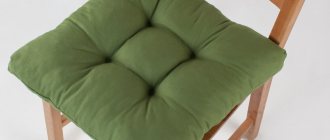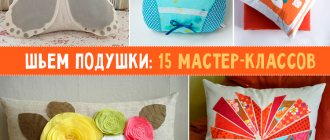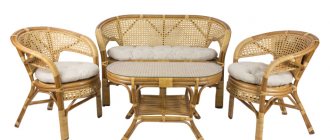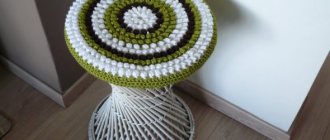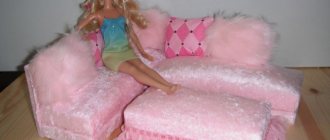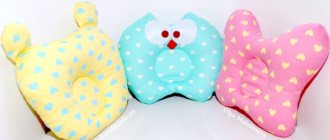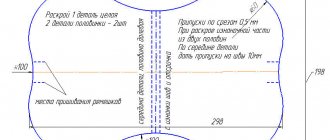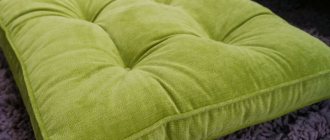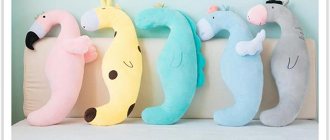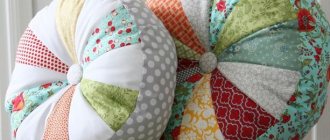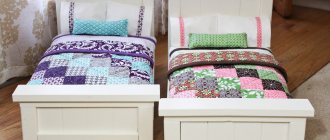It is difficult to find a person’s home that does not have at least one pillow. This bedding has long been used not only for its intended purpose, but also for interior decoration. Sofa cushions, made of decorative materials in the form of squares, triangles and bolsters, create a relaxed atmosphere, make the home cozy and relaxation comfortable.
Don’t despair if the store doesn’t have a pillow of the right color and size. This textile product can be made by hand. The main thing is to choose a high-quality filler and carefully, following the advice of professionals, carry out the work.
Description
What is a pillow made of this material stuffed with? Polyester fibers made from polyester. Non-woven filler made from hollow fibers. They are fastened together using heat treatment. Unscrupulous manufacturers make filler by gluing fibers together. It can be easily identified by the smell of a chemical adhesive.
The thermally bonded fibers are treated on top with antibacterial impregnation and silicone. This improves performance properties. Sintepon is the very first synthetic filler.
The synthetic padding pillow is made from primary raw materials. No recycled waste is used. Recycled material is not of sufficient quality for sleeping textiles. It will quickly begin to roll, the fibers will move, the pillow will become caked, with lumps inside.
Compound
Sintepon was invented and patented by English scientists in 1941. This fiber was obtained from polyester plastic . Spiral-twisted threads of the material are connected to each other by adhesive, needle-punched or thermopolymer methods. The result is a lightweight non-woven material.
The airiness of padding polyester is explained by the fact that the volume of air between the fibers is much greater than the volume of the material itself. The resulting material can additionally be treated with silicone and antistatic agents. Currently, polyethylene terephthalate (PET) and secondary raw materials in the form of polyethylene waste are used to produce synthetic padding. Sometimes natural materials, cotton or wool, are added during the production of padding polyester.
This is interesting: Electric sheet - which one to buy? 7 selection tips, Beurer, Pekatherm
Advantages and disadvantages
Advantages of the material:
- Not allergic. Polyester synthetic fibers are not attractive to germs, mold, parasites, and mites. This reduces the risk of developing allergies.
- Hygiene - synthetic winterizer has no odor. It does not absorb foreign odors. Does not accumulate dust.
- Environmentally friendly due to the absence of adhesives in the production of filler. The fibers are combined under high temperature.
- Good thermoregulation. The porous texture allows you to regulate the temperature. Warm in winter, cool in summer.
- Pillows made from synthetic padding are elastic and quickly return to their shape after mechanical stress.
- Moisture resistance of siliconized fibers. Silicone does not allow moisture inside the thread; the water evaporates quickly. The product will not take long to dry.
- Breathable, good air circulation. Hollow fibers allow air to pass through and help moisture evaporate quickly.
- Easy care. Easy machine wash.
- It's inexpensive. Cheaper than natural and other polyester fillers.
- It weighs a little with a large volume.
Negative properties of padding polyester:
- Not durable, maximum service life is 2 years. At this price, it’s not a pity to update the pillow on time.
- Excessive softness. It will not provide the necessary rigidity.
- Accumulates static electricity. It is necessary to use antistatic agents when washing. Natural pillowcases reduce electrification.
Some people experience health hazards from synthetic padding:
- poor neck support;
- Pain increases due to osteochondrosis and intervertebral hernia.
An allergy to a synthetic padding pillow occurs if the product is cheap, made with the addition of unnecessary chemicals, or has a strong smell.
Natural fillers
Pillows filled with natural materials deservedly hold a leading position, far superior in comfort to products made from synthetics and other materials.
Down and feather of a bird
The feather and down pillow is very soft and comfortable.
Traditionally, natural fillers include down and feathers of various birds: ducks, chickens, geese, swans. A pillow with such a filling is very light and soft, quickly regains its shape, absorbs liquid well and allows air to pass through. Sleeping on it is a pleasure, but only if you are not allergic to dust mites.
The fact is that over time, microorganisms grow inside the feather filling, which can cause attacks of suffocation in people prone to allergies. To prevent this, down and feather products must be properly cared for: dried regularly and taken outside in hot weather, since the easiest way to deal with harmful microorganisms inside the filling is with the help of sunlight.
Camel and sheep wool
Bedding stuffed with camel or sheep wool is incredibly warm and comfortable. In addition, they have a healing effect and can alleviate the condition of people with radiculitis.
However, products with wool filling are heavy, which is their significant drawback. In addition, the wool quickly rolls off, after which it is almost impossible to return the pillow to its original state.
Cotton
One of the most common and popular filling materials among needlewomen is cotton. Eco-friendly and hypoallergenic material has high hygroscopicity and good thermoregulation. Harmful microorganisms will never grow inside such a pillow. If bedding with cotton filling is properly cared for, aired and dried regularly, it will last quite a long time.
Knitwear
A homemade decorative pillow can be stuffed with pieces of cotton fabric or knitwear. Every needlewoman probably has an unnecessary jumper, an old blouse or sweatpants that are destined for the landfill. These things need to be washed, dried thoroughly and cut into small pieces. The filling for the sofa cushion is ready, all that remains is to stuff it into a pre-sewn cover - cheap and beautiful.
Natural yarn
Another option for natural filler that is perfect for stuffing sofa cushions is wool or cotton yarn. If there are deposits of unnecessary threads in the house, they can be sorted out, cut into pieces and used in the manufacture of textiles.
Natural fur
When filling a decorative pillow sewn by yourself, pieces of natural fur from an old fur coat will come in handy. The disadvantage of fur filling is that it collects dust, so the pillow will have to be washed often.
Vegetable filler
The buckwheat husk cushion does not collect dust and does not harbor dust mites.
The following is often used as a filler for decorative pillows:
- dried herbs;
- lemon balm, thyme or mint leaves;
- hop cones;
- buckwheat husk.
Such products give the decoration of the room originality, originality and at the same time saturate the air with pleasant aromas.
Rules of care
If the recommendations are followed, the product will serve its term without changing its appearance or performance characteristics:
- In the morning, beat the product and turn it over, this prevents caking;
- leave the bed straightened out for a while after sleep so that everything can be ventilated;
- humidity in the room should be up to 65%;
- Follow the care information on the label.
How to wash a synthetic padding pillow:
- No more than three times a year in a machine or by hand. No need to pre-soak.
- Use delicate mode, synthetic programs, hand wash or baby clothes. The tank is loaded no more than halfway. Water temperature up to 40 degrees.
- Need liquid laundry detergents. They are easily washed out of this filler. Do not use aggressive bleaches containing chlorine.
- It is necessary to rinse the pillow three times. The structure of the fibers traps the cleaning gel inside.
- Set the minimum spin speed. Machine drying is contraindicated.
- How to fluff a synthetic pad when washing: throw several tennis or special laundry balls into the tank. During the process, they constantly beat the filler. After washing, the damp pillow is treated with a vacuum cleaner: the lumps are moved to an empty place, where they are straightened out under the air flow.
- When washing by hand, place the pillow in water with the product dissolved in it for 20 minutes. Then lightly slap it, drain the water and change it several times while rinsing.
- Dry on a horizontal surface. Sometimes they turn over. You can place a dry cloth.
What to do if the synthetic padding pillow has become felted:
- Check if it needs to be changed. To do this, they place something heavy on it, such as a book. If the shape returns quickly after the item is removed, the item may still serve. Otherwise, it is better to choose a new one.
- Beat with your hands, tap with your palms, shake the pillow. Or use the tips below.
How to fluff padding polyester inside a pillow:
- do after drying through the cover;
- separate the fibers from each other with your fingers;
- tear it open and do everything manually - if the previous method did not help.
The first method is used if there is still a long way to go before washing, but the pillow is a little matted.
The service life of synthetic padding is on average one year. With good care, the product will last a couple of years, but it’s worth checking periodically to see if it’s time to buy a new one. Sleeping on a pillow that has lost its properties is never comfortable.
Pillows on padding polyester, why do they need to be changed so often: of all polyester materials, padding polyester is the most short-lived. It will fall into lumps and cease to be elastic. This is unpleasant and not useful.
Herbal Ingredients
Plant materials are varied and inexpensive, because anything can be included here:
- any dried herbs;
- dried aromatic leaves of mint, thyme or lemon balm;
- hop cones;
- buckwheat husks;
- bones;
- shavings;
- husk;
- sawdust.
Plant ingredients are an almost ideal filling for pillows. Products with them exude a pleasant aroma and delight with a soft rustling sound. You can finger them, thereby relieving tension and calming down. And a pad with buckwheat husk will generally become an orthopedic assistant for you.
This filler is suitable exclusively for decorative pillows that will be used only for beauty. You should not sit or lie on such pads - the cotton wool will instantly turn into lumps and the product will lose its appearance.
Tips for choosing
How to choose a padding polyester pillow:
- The seams should be small, even, continuous. This ensures the safety of the filler inside. When stretching the space around the seam there should be no holes or punctures.
- Natural cotton cover, preferably with a zipper. It makes it easier to wash the cover, clean the filling, and change it if necessary.
- No chemical smell. Many manufacturers do not comply with manufacturing rules, using inexpensive harmful substances and compounds. They can be easily identified by their unpleasant odor.
Whether the synthetic winterizer burns or not: when it burns, it melts and emits a chemical smell. It melts into a lump and emits black smoke.
How to choose?
When choosing a sleep accessory, do not hesitate to test the model you like by lying on it to make sure that it suits you in terms of height, degree of springiness and shape. The height of the pillow varies from 5 to 15 cm. Due to an incorrectly selected parameter, headaches may occur in the morning, normal blood supply to tissues is disrupted, and the muscles of the cervical spine become numb.
The ideal option is when the height of the product matches the width of the user’s shoulder.
Please note three points:
- Quality of tailoring. High-quality seams are an even, continuous stitch consisting of small and frequent stitches: this way the filling will not spill out. Punctures in the material are unacceptable. If you lightly stretch the area around the seam, it should remain intact.
- Case material. Mostly high-quality cotton is used to make covers. The best option: a pillow in a cover with a zipper, which simplifies the tasks of drying, cleaning, and replacing the filling.
- The absence of an unpleasant odor is a prerequisite for all synthetic fillers. Since not every manufacturer is scrupulous about the quality of their products, the use of hazardous materials is practiced in the manufacturing process. The presence of a pungent odor indicates the use of low-quality raw materials.
And one last thing. It is possible that sleeping on a new pillow will be accompanied by some discomfort for some time. Do not rush to conclusions about the unsuitability of the product. The body needs to adapt and get used to sleeping in new conditions. This usually takes a couple of nights.
Making a pillow on padding polyester
What you will need:
- dense fabric for the cover - chintz or calico;
- sheet synthetic filler;
- zipper;
- scissors, thick thread, needle;
- felt-tip pen, ruler;
- sewing machine.
Manufacturing process:
- Cut padding polyester for pillows into squares of 43, 38, 33, 28, 23 cm. Two squares of each size. Each of them is 2.5 cm smaller than the previous one on one side. The value varies from 1.5 to 4 cm, this affects the volume of the pillow.
- Fold two identical pyramids of squares. Then turn one over to the other: the small squares are connected to each other, you get an inverted pyramid on a regular one.
- Hand sew the edges of large layers. The rest should be evenly distributed inside.
- How to properly stuff a pillow with synthetic padding: measure the filler blank and cut out a rectangular cover from it. Leave seam allowances of 1.5-2 cm.
- Sew the cover separately. If you have certain skills, sew piping into the stitching along all edges of the cover. It will make the shape clearer and retain it after washing.
- Turn the cover inside out and put it on the padding polyester blank. Sew up completely using a sewing machine. Another option is to make a zipper on the cover so that you can wash it separately and refill it when the filling becomes old.
When making a pillowcase, add a couple of cm allowances to make it comfortable to put on. It is advisable to make a pillowcase with a zipper, it is convenient and the pillow does not fit out.
How can you replace padding polyester for a pillow:
- Holofiber - polyester balls twisted in a spiral, hollow inside. Lighter than padding polyester, warms better due to the large space for air. Siliconized coating is present.
- Sintepuh - similar in properties to holofiber. It is made by combing polyester fibers. They are also treated with silicone and twisted into spirals. In appearance and properties it is similar to the natural down of waterfowl.
- Ecofiber is an environmentally friendly material similar to natural down. Its thin fibers can simultaneously contain seven hollow channels. It differs from synthetic fluff in its completely environmentally friendly production.
- Comforel - small fluffy balls, up to 6-7 mm. Empty inside. Cheaper than holofiber, will last less.
How much synthetic fluff do you need for a pillow:
- 0.5 kg per 50x50 cm;
- 0.55 kg for 50x60 cm;
- 0.6 kg for 60x60 cm or 50x70 cm.
The remaining options are easy to calculate.
Reviews
1Marina, 21 years old: I’m a student, I don’t have extra money and the ability to take good care of my bed. That's why I buy inexpensive accessories. I have a padding polyester pillow and blanket, I like that they can be washed easily and are quite comfortable to sleep on. 2Grigory, 47 years old: I don’t see anything wrong with padding polyester, I’ve been using such pillows all my life. I bought the last one three years ago, so far so good. 3Vladlena, 38 years old: due to allergies, I don’t use natural materials. The synthetic polyester pillow is inexpensive, I have no allergies to it. But not very comfortable, I like synthetic fluff better. 4Dmitry, 30 years old: I can’t sleep on a synthetic padding pillow. Too soft, then my back hurts. But it’s convenient to take it with you on a trip; you don’t have to worry if it gets dirty or something happens.
Many people will like synthetic pillows for their low maintenance and low price. They are not suitable for people with spinal problems, but others will appreciate their lightness and hypoallergenicity.
© 2022 textiletrend.ru
What is the material
Sintepon refers to non-woven materials. It is made from polyester threads, which are synthetic fibers formed from the melt of polyethylene terephthalate. The material is also obtained from recycled materials - low-quality polyethylene, which undergoes heat treatment. Synthetic winterizer is in great demand, as it costs several times less than natural fiber. The price of the product varies depending on the density and quality of the material used in production.
Items made using padding polyester retain heat well, which is why the material is often used in the production of winter clothing.
What and how are they made from?
Sintepon is made from thin threads in several ways. The most common and modern method, which is very popular, is heat treatment of fibers. The threads are slightly melted and fastened together. This material is called Eurosintepon.
It is soft and elastic to the touch, retains its shape well and is less electrified. Eurosintepon is used in the manufacture of pillows and blankets, as well as for insulating outerwear. The color is white, the fibers are slightly transparent.
Instructions:
- First, overlock 2 pieces of curtain fabric. Sew them together and iron them well. Using a chalk and ruler, mark the fabric from the wrong side. Draw the fabric into 2.5 x 2.5 cm squares and apply the puff pattern you like.
- Fold the fabric in half and mark the middle with a pin. From one end, count the number of marks, get as close to the middle as possible, step back 1 cm from the last square, cut the fabric and process the cut with an overlocker.
- Fold the fabric in half again, but with the markings facing outward. Connect the middle and all parallel lines with pins. Stitch and remove pins. When the workpiece is ready, you can begin forming the buffs.
- The puffs are assembled by pulling the threads according to the pattern. When you complete the 1st tie, do not forget to secure it. Thus, make as many buffs as necessary.
- You can sew a beautiful button into the middle of the finished pillow. Stuff the product with padding polyester and sew.
Instructions:
- To make a pillow with your own hands, you will need patterns. To do this, cut out a rectangle measuring 55x49 cm from a plain fabric.
- From fabric with an ornament, cut out 2 rectangles measuring 16x49 cm.
- Cut out 2 squares of patterned fabric, measuring 20x20 cm.
- Cut out 2 strips of plaid fabric, measuring 5x49 cm.
- Once you have cut out all the main parts, start making the ends of the side panels. Fold the cut out square of patterned fabric in half and then 1.5 times more. Draw an arc, cut along the drawn line. As a result, you should end up with a circle. Do the same with the other square. Gather the circles, leaving 1.5 cm from the edge.
- Connect the rectangles of the middle part of the bolster and the side panels. Fold the resulting rectangle lengthwise. Sew the edges together, leaving a 15cm long hole in the middle of the seam.
- Take the plaid strips, fold them in half and sew the edges. Turn out the resulting circles, bend them in half and iron them.
- Connect the plaid circles to the side panels and stitch. Sew the ends of the roller. Turn the finished pillow-cushion inside out, fill it with filling and sew up the hole with a hidden seam.

